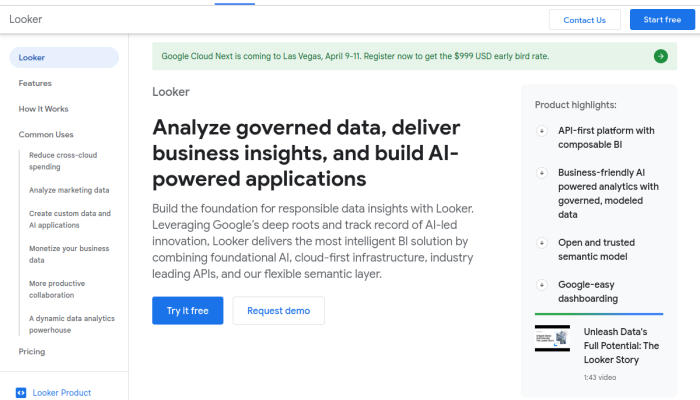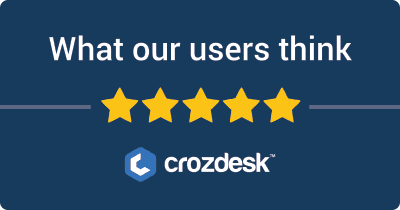
Looker and Mixpanel are two prominent analytics tools that cater to the growing need for data-driven decision-making in businesses. Both platforms enable organizations to derive insights from their data, but they serve different purposes and audiences within the analytics space. Looker is primarily a business intelligence tool focused on data visualization and exploration, allowing users to create comprehensive dashboards and reports. In contrast, Mixpanel specializes in product and event analytics, helping teams track user interactions and engagement to optimize their offerings.
Users commonly consider Looker and Mixpanel for their robust features, ability to handle large datasets, and capacity to generate actionable insights. For teams focusing on product development and user behavior, Mixpanel offers in-depth tracking capabilities, while Looker provides a more holistic view of business metrics and performance through its visualization strengths.
Key comparison aspects include:
-
Features: Looker excels in data modeling and visual reporting, whereas Mixpanel offers advanced event tracking and cohort analysis.
-
Pricing: Both tools have different pricing models that cater to various business sizes and needs, making it essential to compare costs based on user requirements.
-
Ease of Use: Looker’s interface is oriented towards data analysts, while Mixpanel aims for accessibility for product teams, which may impact user adoption based on team composition.
By examining these aspects, users can make informed decisions on which analytics tool aligns best with their specific needs and objectives.
Looker VS Mixpanel: Which tool is the most popular?
| Tool | Number of Reviews | Average Rating | Positive Reviews | Neutral Reviews | Negative Reviews |
|---|---|---|---|---|---|
| Looker | 20 | 4.5 | 19 | 1 | 0 |
| Mixpanel | 31 | 3.97 | 26 | 2 | 3 |
Looker is the most popular tool based on both average rating (4.5) and a high proportion of positive reviews (95%). It has received a total of 20 reviews.
Mixpanel, while having a higher number of total reviews (31), has a lower average rating of approximately 3.97 and a smaller percentage of positive feedback (83.87%). It also has 3 negative reviews, indicating some issues reported by users.
Overall, Looker demonstrates higher user satisfaction and a more favorable reception compared to Mixpanel.


Looker and Mixpanel: Quick Comparison Overview
| Feature/Aspect | Ahrefs | SEMrush |
|---|---|---|
| Primary Features | – Site Explorer – Keyword Explorer – Backlink Checker – Content Explorer – Rank Tracker |
– Keyword Research – Site Audit – Position Tracking – Content Analyzer – Marketing Insights |
| Target Audience | – SEO professionals – Digital marketers – Agencies focusing on content marketing and backlink analysis |
– Digital marketers – SEO experts – Content marketers – Social media marketers and PPC specialists |
| Main Advantages | – Robust backlink analysis – Comprehensive keyword data – Intuitive user interface – Constantly updated index |
– All-in-one digital marketing tool – Extensive competitor analysis – Wide array of tools for SEO and PPC – Integrated social media management |
| Core Value Proposition | Focused on providing in-depth SEO insights, particularly strengths in backlink profiles and organic keyword rankings. Ideal for users prioritizing content strategy and link-building efforts. | Offers a holistic view of digital marketing, making it easier to manage all aspects of online presence through an extensive range of tools for SEO, PPC, and social media marketing. |
| Ideal Use Cases | – Conducting comprehensive link audits – Developing effective content strategies – Tracking backlinks and organic rankings – Keyword planning for SEO campaigns |
– Managing and optimizing PPC campaigns – Conducting competitive analysis for market positioning – Comprehensive content analytics and SEO tracking – Social media metrics and management |
Most liked vs most disliked features of Looker and Mixpanel
| Tool | Overall User Sentiment |
|---|---|
| Looker | – Most Liked Features: – Simplifies navigation and report creation for all users. – Effective tools for dashboard creation. – Seamless integration with Google tools. – Customizable dashboards and reports. – Automatic data importing for timely updates. – Most Disliked Features: – New users face navigation challenges. – Reports of lags and freezing with complex datasets. – Limitations in data transformation capabilities. – Some interface elements are seen as simplistic. – Time-consuming setup for connecting data sources. |
| Mixpanel | – Most Liked Features: – Comprehensive analytics for user behavior insights. – Accessible user interface for onboarding. – Real-time tracking for immediate decisions. – Effective segmentation features for marketing. – Responsive customer support. – Most Disliked Features: – Complex interface leading to a steep learning curve. – High pricing perceived as a barrier for small businesses. – Lack of auto-save and limited user management. – Inadequate support resources and documentation. – Need for better integration with other tools. |
Key Features of Looker vs Mixpanel
Looker Key Features:
-
Data Modeling:
- Benefit: Looker’s LookML allows users to create a centralized data model. This ensures consistent definitions and calculations across the organization, reducing discrepancies in reporting.
- Unique Aspect: Looker’s approach to data modeling is highly customizable, allowing users to define measures and dimensions that are relevant to their specific needs.
-
Real-time Data Exploration:
- Benefit: Users can interact with their data in real-time, enabling quick discoveries and insights without waiting for batch data processing.
- Unique Aspect: This real-time capability allows for more agile decision-making processes as users can analyze current data trends.
-
Collaborative Analytics:
- Benefit: Looker facilitates teamwork by allowing users to create shared dashboards and reports that can be commented on, fostering collaboration.
- Unique Aspect: The built-in commenting feature enables contextual conversations about the data directly within the platform.
-
Data Visualization:
- Benefit: Users can create diverse and attractive visual representations of their data, making it easier to interpret and share insights.
- Unique Aspect: Looker includes a robust set of visualization options that can be customized, catering to varied data storytelling needs.
-
Embed Analytics:
- Benefit: Companies can embed Looker’s analytics within their applications, providing tailored insights to users without leaving their workflows.
- Unique Aspect: Looker’s embedding comes with customizable dashboards that can reflect the brand’s identity, enhancing user experience.
-
Integration:
- Benefit: Looker seamlessly connects with several data sources and tools, allowing for a unified view of data across platforms.
- Unique Aspect: The extensive integrations enable organizations to utilize existing tech stacks effectively without needing to overhaul systems.
Mixpanel Key Features:
-
Event Tracking:
- Benefit: Users can track specific user actions within their products, providing insights into user behavior and engagement.
- Unique Aspect: Unlike traditional analytics tools that often focus on page views, Mixpanel is built around event-based analytics, allowing for a granular understanding of user interactions.
-
Funnel Analysis:
- Benefit: Allows users to visualize the steps users take toward conversion, identifying where drop-offs occur, and optimizing the conversion process.
- Unique Aspect: Mixpanel’s funnels are dynamic, allowing for real-time tracking of user journeys, which aids in optimizing user flows quickly.
-
Cohort Analysis:
- Benefit: Users can segment their audience based on behaviors over time, helping teams tailor their marketing and product strategies.
- Unique Aspect: Mixpanel allows for retroactive cohort comparisons, which can reveal trends over time without losing historical context.
-
Retention Tracking:
- Benefit: This feature helps understand how often users return to engage with the product, providing insights into user loyalty and product stickiness.
- Unique Aspect: The ability to analyze retention in real-time allows teams to quickly implement changes and measure their impacts.
-
Data Visualization:
- Benefit: Mixpanel provides intuitive dashboards and visualizations for better understanding user behavior and trends.
- Unique Aspect: Their visualizations are focused specifically on user actions and engagement metrics, leading to actionable insights.
-
Integrations and API:
- Benefit: Mixpanel can integrate with various other tools and platforms, allowing for a more comprehensive data ecosystem.
- Unique Aspect: The API is designed to easily capture events and property data, making it user-friendly for developers.
Summary: While both Looker and Mixpanel serve the analytics toolkit, they cater to different user needs. Looker excels in data modeling and visualization for ad-hoc and business intelligence needs, providing a centralized approach to inter-departmental data consistency. Mixpanel, on the other hand, focuses on understanding user behavior through event tracking and cohort analysis, making it ideal for product managers and marketers looking to optimize user engagement and conversion paths. Each tool offers unique aspects that cater to their respective user bases, thereby addressing specific challenges in analytics.
Looker vs Mixpanel Pricing Comparison
| Feature/Plan | Looker Pricing (Estimated as details not openly available) | Mixpanel Plans |
|---|---|---|
| Free Trial | Not explicitly mentioned | 14-day free trial |
| Pricing Tiers | Not publicly disclosed; customized quotes based on needs | 1. Starter 2. Growth 3. Enterprise |
| Starter Pricing | Not available; custom pricing only | $0 for up to 100,000 data points/month |
| Growth Pricing | N/A | Starts at $25/month for 1,000,000 data points/month |
| Enterprise Pricing | N/A | Custom pricing depending on user needs |
| Notable Features (Starter) | N/A | Core analytics capabilities, unlimited dashboards, and basic integrations |
| Notable Features (Growth) | N/A | Advanced analytics features, additional integrations, and more comprehensive support |
| Notable Features (Enterprise) | N/A | Custom solutions, enterprise-grade security, dedicated support, and advanced analytics capabilities |
| Discounts | No standard discounts; custom deals may be available | Annual commitment discounts available |
Key Differences:
- Free Trials: Mixpanel offers a 14-day free trial; Looker does not specify a trial period.
- Pricing Transparency: Mixpanel provides clear tier pricing; Looker relies on custom quotes, making it less transparent.
- Data Points: Mixpanel’s Starter plan has a limit of 100,000 data points per month, while the Growth plan allows for 1,000,000 data points at a base price.
- Feature Sets: Looker’s tier offerings are less defined, while Mixpanel clearly differentiates between the capabilities available in Starter, Growth, and Enterprise levels.
- Enterprise Solutions: Both brands provide custom enterprise solutions, but Mixpanel specifically mentions advanced security and dedicated support as part of their service.
This comparison focuses on the availability and structure of pricing and feature sets from both platforms.
Support Options Comparison: Looker vs Mixpanel
| Support Option | Looker | Mixpanel |
|---|---|---|
| Live Chat | Available for Looker customers through their support page during business hours | Available for Mixpanel customers, typically with responsive support during business hours |
| Phone Support | Not offered | Available, with a dedicated support line for customers on certain plans |
| Documentation | Comprehensive documentation available, including user guides, API reference, and troubleshooting assistance | Extensive documentation covering various topics, including guides, API information, and best practices |
| Additional Resources | Webinars and tutorials available; regular training sessions offered for users | Offers tutorials and webinars for users to enhance understanding and utilization of the platform |
Unique Features of Looker Vs Mixpanel
| Feature | Looker | Mixpanel | Added Value & Decision Factors |
|---|---|---|---|
| LookML | Proprietary modeling language for data modeling. | N/A | Allows for advanced data modeling, enabling organizations to define metrics consistently and adapt to changes. This can reduce discrepancies and promote better data governance. |
| Data Exploration | In-depth exploration capabilities with custom fields. | Basic exploration tools. | Provides comprehensive data exploration, empowering users to delve deeper into data relationships and uncover insights that are tailored to specific needs. |
| Embedded Analytics | Supports embedding Looker content within other applications. | Limited embedding options. | Facilitates seamless integration of analytics into business applications, enhancing user engagement and fostering data-driven decisions across platforms. |
| Dashboard Interactivity | Highly customizable dashboards with interactive elements. | Standard dashboards with limited interactivity. | Enhances user experience by allowing real-time data interactions, helping stakeholders analyze metrics more effectively and derive actionable insights quickly. |
| Cross-Cloud Compatibility | Supports multiple cloud data sources simultaneously. | Primarily focused on single cloud solutions. | Broadens data integration capabilities, ensuring that organizations can leverage data from various cloud providers efficiently, thus maintaining flexibility. |
| Workflow Integration | Strong integration options for workflows (e.g., alerts, scheduling). | Basic integration capabilities. | Enables teams to automate actions based on data insights, streamlining operations and ensuring timely responses to business needs. |
| Data Governance | Strong focus on data governance and security protocols. | Limited governance features. | Ensures that data integrity and security are maintained, making it crucial for businesses that prioritize compliance and data stewardship. |
| Real-time Analytics | Near real-time data processing capabilities. | Focus on historical data analysis. | Facilitates timely decision-making by allowing users to access the most current data, which can be a critical advantage in fast-paced environments. |
| Customizable Access Controls | Detailed user access permissions and roles. | Basic user permissions. | Provides organizations with granular control over who can access and modify data, enhancing security and compliance efforts. |
| Integrated Machine Learning Tools | Built-in ML tools for predictive analytics. | Basic analytics with no dedicated ML features. | Positions businesses to leverage predictive capabilities easily, allowing for more forward-thinking strategies based on data-driven forecasts. |
Selecting the right analytics tool can hinge on these unique features, especially those that enhance data modeling, exploration, and governance. Businesses that prioritize flexibility, real-time insights, and integration capabilities may find Looker’s offerings particularly compelling, while those focused on user-friendly engagement might lean towards Mixpanel for its straightforward analytics features. The decision ultimately revolves around aligning the tool’s strengths with business needs and objectives.


